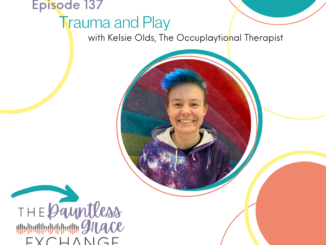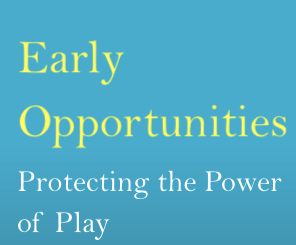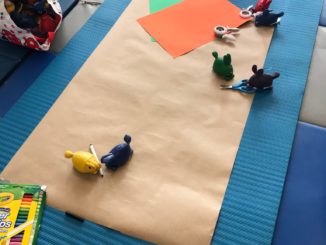(descriptions of the images throughout this post are all contained at the end so that they tell one coherent narrative :))
It might, or it might not, surprise you to learn that I am very rarely a “set up play activities for my kid” type of parent.
I like to set out a new, novel thing (whether that’s a formal toy, or a random piece of recycling I found, or a craft item, or whatever) and let them “discover” it and figure out a way to play with it for themselves, the vast majority of the time when we need something new in our family.
But, on this day, I knew that my sensory-seeking* daughter specifically needed movement, and for us personally it was too rainy and cold to go outside. So I needed to set up something that would channel her movement in the right way, because bouncing off the walls and climbing all over her (annoyed) brother wasn’t working for anyone in the family.
I cleared the space in our house that creates the longest stretch that someone would be able to run before they ran into a wall — where the playroom meets the living room. I wrote 3 words on pieces of paper and taped them to one wall with painter’s tape. I made little slips of paper that said the words, had the starting letter of each word, or had a drawing of each word on them and taped them all over the opposite wall, from up high to down low.

So on the far wall was “cat”, “fish”, and “mouse”. She loves cats and mice, and I picked “fish” because she doesn’t like dogs and it was the next easiest thing to sound out that I could think of. She can read basic consonant-vowel-consonant words right now, and she knows all the letters of the alphabet, so I figured if nothing else she could probably figure out the words by their first letter. And on the opposing wall were 15 paper slips: 2 that said “cat”, one that said “c”, and two with a cat drawing; and so on, for fish and mouse. I read her the words ahead of time, and they each had a drawing, so she knew what they were.

Then I sat myself beside the three papers on the wall and said “run down and get one! Then run back and match it!” She picked up on the concept immediately. (She had watched me prep the whole thing.) Laughing hysterically, she ran through the house, grabbed a paper slip, ran back, and matched it.

She did that for all fifteen. I made sure to put some high enough that she needed to climb up on a chair or on the couch. After she did a full round, she still wanted to do more, so I added more words (Lilo, Stitch) and then we did yet another round with even more words (Jumba, Pleakley, baby).

It was really fun to get to watch her get excited about sounding out the words! She gave it her best effort at even the long words, and was personally deeply motivated to read Lilo and Stitch related words. As I suspected, she mostly figured them out from their first letter, but she felt accomplished because she got to practice reading big words.

The next day, we repeated the activity at another high-energy time. This time I did the words happy, sad, mad, silly, love. (Again, I told her what the words were, and read them for her once, before the game started.) I didn’t tell her any new instructions but I quietly wondered to myself if I’d find a way to incorporate something about emotions into the game. I didn’t have to tell her to do anything — she started reading out the word or interpreting the picture, and then mimicking the emotion herself with her face and body language. So she read “sad” and made an exaggerated sad face, boo-hooing noises and came to me for a cuddle. I really liked that element of it, because pretending to go through the different emotions and mimicking what it would take to regulate is play…and play is how kids learn…including emotions and self-regulation. 🙂

I also included both “sad” and “silly” in the second round because I was curious how she would handle having two words starting with an “s” — she would have to really read at least one of them, not only interpret it by the first letter! She did a great job. I thought she would know “sad” and not “silly” because “sad” is only three letters long. But funnily enough, she got confused with “sad” because of mixing up b/d*. She read it first as “bas” and then as “sab” and didn’t know what it meant, coming to me for help. But with “silly”, she recognized the “l”s quickly and said “this one is ‘sss’ and ‘lll’. That’s ‘silly’!”
Sometimes during the game she would run, and other times she would put her hands down and run on all fours, something that she has done ever since she was very small. This gives a great upper-body and core workout, as well as intense proprioceptive* feedback through the body. Upper body and core strength are important precursors for being able to do fine motor tasks like write. Proprioceptive feedback is important for self-regulation. So this was an awesome addition to the game that she instinctively did!
*If this term is new to you check out this post!
[Image descriptions:
Altogether, the images show the progression of this game, so that someone could set it up at their home or in their learning setting as well if they wanted to.
The first image shows the wall with three pieces of green construction paper taped to it that say “mouse”, “fish”, and “cat” with little doodle drawings of a mouse, a fish, and a cat.
The next image shows the door and wall where all the slips of paper are taped with all the little words on them.
Then there is an image showing my daughter climbing up on a big comfy chair in our living room and retrieving a paper slip off the wall where it’s stuck. Other paper slips are taped around on the wall and on a large glass door that leads to the back garden. Random toys and objects are strewn on the floor but shoved out of the way for safety while running.
There is an image showing my daughter sticking a “fish” paper slip onto the “fish” paper where it’s on the wall. My daughter is a blur with a silver velvet dress and fuzzy, cat-shaped hair accessories.
There is a picture showing the “Lilo” and “Stitch” papers and a pile of paper slips to go with them. Both Lilo and Stitch are illustrated in stick-figure style and the doodle Stitch is a little bit terrifying/cute.
The last picture shows 5 pieces of paper on the wall that read “sad”, “silly”, “love”, “mad”, and “happy” each with a doodle drawing indicating that emotion as well.
End descriptions.]



